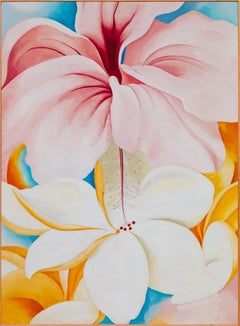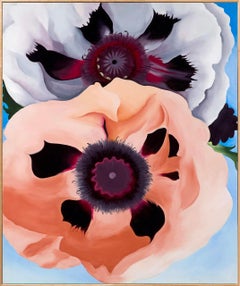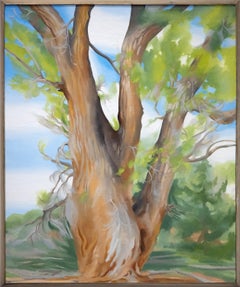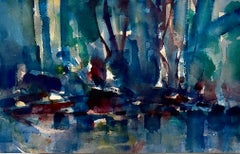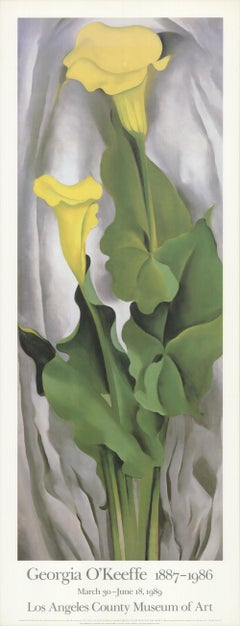Georgia O'Keeffe Art
American, 1887-1986
Georgia Totto O'Keeffe (November 15, 1887 – March 6, 1986) was an American modernist painter and draftswoman whose career spanned seven decades and whose work remained largely independent of major art movements. Called the "Mother of American modernism", O'Keeffe gained international recognition for her meticulous paintings of natural forms, particularly flowers and desert-inspired landscapes, which were often drawn from and related to places and environments in which she lived.
In 2014, O'Keeffe's 1932 painting Jimson Weed/White Flower No. 1 sold for $44,405,000. After her death, the Georgia O'Keeffe Museum was established in Santa Fe.
Early years: She moved to New York in 1918 and began working seriously as an artist. O'Keeffe created many forms of abstract art, including close-ups of flowers, such as the Red Canna paintings, that many found to represent vulvas, though O'Keeffe consistently denied that intention. The imputation of the depiction of women's sexuality was also fueled by explicit and sensuous photographs of O'Keeffe that her husband had taken and exhibited.
O'Keeffe and Stieglitz ( her Husband) lived together in New York until 1929, when O'Keeffe began spending part of the year in the Southwest, which served as inspiration for her paintings of New Mexico landscapes and images of animal skulls, such as Cow's Skull: Red, White, and Blue (1931) and Summer Days (1936).
later years: After Stieglitz's death, she lived in New Mexico her Home and Studio in Abiquiú until later years of her life, when she lived in Santa Fe.
Edited from Wikipedia(Biography provided by GSY Studio)
1
to
1
1
5
6
1
3
2
Overall Height
to
Overall Width
to
1
1
4
3
2
2
1
1
1
1
2
4
1
8
6,997
3,373
2,513
1,212
5
4
1
1
1
Artist: Georgia O'Keeffe
Georgia O'Keeffe-High Quality print by MoMA circa1997-Abstraction Blue-GSYStudio
By Georgia O'Keeffe
Located in London, GB
This silver gilded hardwood frame with O'Keeffe's fine art print, produced by MoMA and acquired by GSY Studio in 1997 in New York, has been an integral part of the GSY Gallery House ...
Category
1990s Abstract Georgia O'Keeffe Art
Materials
Wood, Adhesive, Archival Ink
Georgia O'Keeffe: Jimson Weed/White Flower No. 1 Framed Print
By Georgia O'Keeffe
Located in Central, HK
This print features a reproduction of Jimson Weed/White Flower No. 1 (1932) by Georgia O'Keeffe. It's mounted, laminated and floated in a 2"- deep black as...
Category
2010s Georgia O'Keeffe Art
Materials
Paper, Wood
Georgia O'Keeffe - Grey Lines Framed Print
By Georgia O'Keeffe
Located in Central, HK
This framed print features a reproduction of Grey Lines with Black, Blue, and Yellow (c. 1923) by Georgia O'Keeffe, a world renowned artist. The piece mounted and laminated for prote...
Category
2010s Georgia O'Keeffe Art
Materials
Paper, Wood
Georgia O’Keeffe Hibiscus Framed Print
By Georgia O'Keeffe
Located in Central, HK
This print features a reproduction of Hibiscus with Plumeria (1939) by Georgia O'Keeffe. It’s mounted and laminated for protection from dust and UV rays, and floated in a hand-staine...
Category
2010s Georgia O'Keeffe Art
Materials
Paper, Wood
Georgia O’Keeffe Poppies Framed Print, 2019-2022
By Georgia O'Keeffe
Located in Central, HK
This print features a reproduction of Poppies (1950) by Georgia O'Keeffe, an artist whose works are world renowned. It's mounted and laminated for protection from dust and UV rays, a...
Category
2010s Georgia O'Keeffe Art
Materials
Paper, Wood
Cottonwood Tree (Near Abiquiu), New Mexico
By Georgia O'Keeffe
Located in Palm Desert, CA
A painting by Georgia O'Keeffe . "Cottonwood Tree (Near Abiquiu), New Mexico" is a modern art oil on canvas by American female artist Georgia O'Keeffe. Georgia O’Keeffe was among the most influential figures in Modernism, best known for her large-format paintings of natural forms, especially flowers and bones, and for her depictions of New York City skyscrapers and architectural and landscape forms unique to northern New Mexico.
Provenance:
An American Place, New York
Mr. and Mrs. Max Ascoli, New York, 1944
Descended in family
Harold Diamond, New York, c. 1975
Gerald Peters...
Category
20th Century American Modern Georgia O'Keeffe Art
Materials
Oil, Canvas
Related Items
Bernard Villemot for Bally
By Bernard Villemot
Located in Saint Ouen, FR
Bernard Villemot for Bally
Lithography
1982
42,5x64,5cm
290€
Category
1980s Georgia O'Keeffe Art
Materials
Paper
Modernist Abstract Expressionist Watercolor Painting Bauhaus Weimar Pawel Kontny
By Pawel Kontny
Located in Surfside, FL
Abstract watercolor composition bearing the influence of the earlier color-block compositions of Paul Klee.
Pawel August Kontny, (Polish-German-American artist) He was born in Laurahuette, Poland, in 1923, the son of a wealthy pastry shop owner. In 1939 he began studying architecture in Breslau where he was introduced to the European masters and to the work of some of the German Expressionists, soon afterward banned as "degenerate artists" and removed from museums throughout Germany by the Nazi regime. His studies were interrupted by World War II. Drafted into the German army, traveling in many countries as a soldier, he sketched various landscapes but in 1945, he was captured and held as a prisoner of war in Italy. After the war, he studied at the Union of Nuremberg Architects to help design buildings to replace ones destroyed in the war. He recorded his impressions of the local population and the landscapes through his watercolors and drawings. Pawel Kontny thereafter moved to Nuremberg, Germany, becoming a member of the Union of Nuremberg Architects and helping to rebuild the city's historic center. He soon decided to concentrate on his professional art career. He married Irmgard Laurer, a dancer with the Nuremberg Opera. Pavel Kontny 's career as an artist was launched with his participation in an all German exhibition, held at the Dusseldorf Museum in 1952. He held one-man shows in Germany, Switzerland and the United States. During his trip to the United States in 1960, Kontny became instantly enamored with Colorado, and decided to relocate to Cherry Hills with his wife and two children. He quickly established himself in the local art community, being affiliated for a time with Denver Art Galleries and Saks Galleries. His subject matter became the Southwest. During this time he received the Prestigious Gold Medal of the Art Academy of Rome. His extensive travel provided material for the paintings he did using his hallmark marble dust technique. he also worked equally in pastel, watercolor, charcoal and pencil-and-ink. in a style which merged abstraction and realist styles, influenced by Abstract Expressionist painting and South Western American landscapes. In the early 1960s he was one of only a few European-born professional artists in the state, a select group that included Herbert Bayer (1900-1985), a member of the prewar Bauhaus in Weimar and Dessau, Germany, and Roland Detre (1903-2001), a Hungarian modernist painter. As a Denver, Colorado resident, Pavel Kontny exhibited at galleries and museums throughout the United States, Germany and Japan. There, he was inspired by frequent trips to Native American pueblos in the Southwest, as well as by the study of the Plains Indians of Montana and Wyoming. Over the years Kontny had a number of students and generously helped young artist by hosting exhibitions at his Cherry Hills home. For many years he generously donated his paintings to support charitable causes in Denver. Influences during his European years included German pastelist C.O. Muller, German Informel painter Karl Dahmen and Swiss artist, Hans Erni. In the early 1950s his painting style showed the influence of the Die Brücke (The Bridge), a group of German expressionist artists formed in Dresden in 1905 who had a major impact on the evolution of modern art in the twentieth century in Germany. By the middle of the decade his style incorporated more referential abstraction and total abstraction, resulting in part from his study of Hans Hartung, a German artist based in Paris who exhibited his gestural abstract work in Germany. The American moon landing in 1969 inspired Paul Kontny...
Category
20th Century American Modern Georgia O'Keeffe Art
Materials
Canvas, Oil
Central City, Colorado, 1950s Modernist Cityscape Oil Painting with Buildings
Located in Denver, CO
Oil on canvas modernist city scape painted circa 1950 by Paul K Smith (1893-1977) titled Central City, Colorado. Portrays a city scene of historic buildin...
Category
1950s American Modern Georgia O'Keeffe Art
Materials
Canvas, Oil
“Abstract Sailboats”
By William Katz
Located in Southampton, NY
Fabulous original mid century modern oil on canvas painting by the well known New York artist, William Katz. The painting is done in a colorful abstraction of sailboats and is signed by the artist lower left. The artist has mixed sand into the oil paint to give the painting a highly textured look. Condition is excellent. Circa 1955. The frame is original with a studded gold edge detailing and with natural wood sides. Frame is in fine original condition. Overall framed measurements are 17 by 29.25 inches. Provenance: A Saint Petersburg, Florida collector.
William P. Katz (1926-2003) American
William Katz was born in New York, studied at The Art Students League and with Sebastiano Mineo of New York City. For five years he worked and lived in the home that was once occupied by the great American sculptor Gutson Borglum. His works are in many private collections in the United States, Norway, England, Canada and Greece.
Best known for sculptures, he also created paintings and designed textiles and jewelry. Alexander Kirkland called him an abstract "figurist-fantasist."
He has had one-man exhibits at many galleries including: 1964, Miami Museum of Modern Art, Miami, FL; 1965, Fordham University...
Category
1950s American Modern Georgia O'Keeffe Art
Materials
Oil, Canvas
"Study of Mt. Vesuvius" Oil on Canvas, Blue Tones, Landscape
By Joseph Stella
Located in Detroit, MI
SALE ONE WEEK ONLY
“Study of Mt. Vesuvius" is a small intimate painting of an active volcano that has at times wrecked great destruction. As seen from a distance, it is a calm blue ...
Category
Late 20th Century American Modern Georgia O'Keeffe Art
Materials
Canvas, Oil
1940's Abstract Composition Jazz Lithograph Pencil Signed and Dated WPA Artist
By Konrad Cramer
Located in Surfside, FL
Konrad Cramer, 1888-1963 was a painter, photographer, printer, and illustrator.
Based in the fertile Woodstock, New York, artistic community along with Yasuo Kuniyoshi and Russell Lee, Cramer was both educator and artist. He ran a summer school for miniature camera photography in the 1930s and later taught one of the first American college courses in photography at Bard College. Although he began as a painter of abstract, geometric forms in bold colors, Cramer is most known as a photographer.
Konrad Cramer was born and raised in Wurzburg, Germany. Cramer studied to be an artist at the Karlsruhe Academy under Ludwig Schmidt-Reutte and Ernest Schurth. He became interested in the German avant-garde early in his schooling, he was a member of the Blaue Reiter, exposed and encouraged by the experimental works of Wassily Kandinsky and Franz Marc. An additional influence on Cramer's artistic development was the Cubist landscapes of Paul Cézanne.
Florence Ballin Cramer opened a gallery on 57th Street in 1919, encouraged by the sculptor Elie Nadelman. Florence Gallery exhibited and sold the works of living artists. Although it only survived briefly, it was the first New York gallery to show works by Yasuo Kuniyoshi, Alexander Brook, Ernest Fiene, and Stefan Hirsch. Cramer then settled with his wife in Woodstock, New York, where Ballin had painted with the Art Students League each summer since 1906. Cramer established a reputation as one of Woodstock's most modern painters with an impressive series of abstract paintings exhibited at the MacDowell Club in 1913. In the 1920s Cramer developed a personal representational style which blended modern and regional influences. Cramer received a Rockefeller grant in 1920 to study educational methods for craftsmen in Germany and France. In 1922 he took a teaching position at the Woodstock School of Painting and helped establish the Woodstock Artists Association, where he served as a director. While teaching and painting, Cramer also applied his artistic talent to illustration and textile design.
Konrad Cramer first exhibited at the Whitney Studio Club in 1924 and participated in the Whitney Museum of American Art's first and second biennials in 1933 and 1935. He was also included in the 1935 exhibition Abstract Painting in America at the Whitney. Cramer was later included in the Whitney Museum exhibition Pioneers of Modern Art in America in 1946. In the 1930s Cramer participated in many other museum invitationals, including: the Carnegie International (1929, 1933, 1937, 1938); the Pennsylvania Academy of the Fine Arts (1934, 1936), and the Corcoran Gallery of Art (1935, 1937).
In 1934 Konrad Cramer and his wife travelled to Mexico where they produced many paintings and drawings. Back in Woodstock in 1935, Cramer briefly joined the (WPA) Federal Art Project, administering the regional program in Woodstock. In the mid-1930s Cramer took up photography to clarify aesthetic issues in his painting. Cramer had gotten to know Alfred Stieglitz upon his arrival in America in 1911 and wrote an essay about 291 Gallery for Stieglitz's magazine Camera Work in 1914. Through Stieglitz and then in the 1930s fellow Woodstockers like Russell Lee, Cramer became interested in the possibilities of photography and began working with it as an artistic medium. In the 1950s Cramer collaborated on a traveling exhibition and book of abstract photographs with Manuel Komroff...
Category
1940s Abstract Georgia O'Keeffe Art
Materials
Lithograph
Kerry Day, Swiss Cheese Plant, Limited Edition Print, Floral Art, Bright Art
By Kerry Day
Located in Deddington, GB
Kerry Day
Swiss Cheese
Limited Edition 7 Layered Linocut Print
Edition of 10
Image Size: H 30.4cm x W 30.5cm
Sheet Size: H 43cm x W 42cm x D 0.1cm
Sold Un...
Category
21st Century and Contemporary Abstract Geometric Georgia O'Keeffe Art
Materials
Paper, Linocut
Free Shipping
H 16.93 in W 16.54 in
fern-butterfly effect f-1
By Seiko Tachibana
Located in Palm Springs, CA
Medium: intaglio
Year: 2015
Signed Artist Proof from the edition of 25
Image Size: 7.5 x 6 inches
Paper Size: 15 x 11 inches
Signed and numbered by the artist.
Seiko Tachibana's...
Category
2010s Abstract Geometric Georgia O'Keeffe Art
Materials
Etching, Aquatint
"Signs of the Times" LOCATION / AT 40x40" on Canvas
By Robin Morris
Located in Southampton, NY
The paintings of Robin Morris are her observations of life, stylized, playful, and yet challenging to the viewer. Her emotions are hidden beneath layers of color and pattern.
Stepping into the public eye in 1982, with the publication of her first lithograph, "The Couple". The fifty editions that followed, firmly established her in the artistic community and enhanced her broad-based collector appeal.
This print on canvas is a particularly rare image. It is numbered 11 of 295 images, but only 3 were ever created of this 40x40" image on canvas. One print went to the artist Robin Morris, One went to us at ARDT gallery...
Category
2010s Pop Art Georgia O'Keeffe Art
Materials
Canvas, Archival Ink
Boys Swimming Industrial Landscape WPA Mid 20th Century Social Realism Modernism
By Henry Ernst Schnakenberg
Located in New York, NY
Boys Swimming Industrial Landscape WPA Mid 20th Century Social Realism Modernism
Henry Schnakenberg (1982 - 1970)
Boys Swimming Industrial Landscape
11 1/2 x 15 1/2 sight
Oil on Canvas
Signed lower left
14 1/2 x 18 1/2 inches, Framed
Bio
In many cases, American artists visited the Armory Show in New York in 1913, and returned to their studios to react to or against what they saw. However, for Henry Ernest Schnakenberg it was much more life altering. Prior to visiting this important exhibition of American and European modernist art...
Category
1940s American Modern Georgia O'Keeffe Art
Materials
Oil, Canvas
Abandoned (Colorado) - Oil on Canvas, American Modern Landscape Painting
By William Sanderson
Located in Denver, CO
'Abandoned (Colorado)' is an oil painting by William Sanderson (1905-1990) depicting an abandoned house in green grass hills. Presented in a custom frame measuring 13 ¼ x 16 ½ inches; image size measures 8 ½ x 11 ¼ inches.
Painting is in good condition - please contact us for a detailed condition report.
About the Artist:
Born Latvia 1905
Died Colorado 1990
The elder son of a construction engineer, he was born Wilhelm Tsiegelnitsky in a seaside resort near Riga, Latvia, then part of the Russian Empire. His father, Grigori Mojesevich (later Anglicized to Gregory) was of Russian-Jewish heritage, while his mother Berta (Bertha) came from a German-Jewish background. Because preference in awarding construction contracts at that time were being given to members of the Russian Orthodox Church, his father had the whole family baptized in that church which he kept a secret from Sanderson’s grandparents.
His father’s profession took the family to a number of cities in various parts of the Russian Empire including Warsaw, Kharkhov, Kiev, and Samarkand in Asia. To his mother’s annoyance, he scribbled on anything within easy reach, deciding by age ten that he would make art his lifetime goal. During the Bolshevik Revolution in 1917 the family lived with relatives in Rostov-on-the-Don where his mother enrolled him in the local Chinyenov Art School, marking the first step in his art career.
Feeling that they would have no place in the new Communist political reality, in 1921 the family left Rostov for Kiev, emigrating to Italy and Greece on short-term visas before arriving in New York two years later, sponsored by Gregory’s relatives in New Jersey. The Tsiegelnitsky surname was changed to the more pronounceable Siegel. Experiencing the frustration shared by most immigrants seeking to establish themselves in a new, unfamiliar environment, Sanderson sufficiently mastered English by 1924 to attend the Fawcett School of Industrial Art in Newark (later the Newark School of Fine and Industrial Art) where he studied with Ida Wells Stroud, herself a student of William Merritt Chase and Arthur Dow and part of the early twentieth-century Arts & Crafts Movement.
Seeking a more challenging curriculum, he enrolled at the National Academy of Design in Manhattan (1924-1927), studying painting with Charles Hawthorne, etching with William Auerbach-Levy, and life drawing with Charles L. Hinton. Sanderson won the Suydam Medal for Life Drawing, First Prize in Composition, and Honorable Mention in Etching. He also briefly attended the Art Students League in New York in 1928, studying lithography with Charles Locke who in 1936 taught a summer course in the medium at the Colorado Springs Fine Arts Center. However, Sanderson quit the League when he could no longer afford the tuition.
With his art studies behind him, he began a successful career in illustration in New York. Briefly associated with the Evening Graphic, he maintained a decade-long affiliation with the New Masses, honored to be in the company of such established artist-contributors as Jean Charlot, Stuart Davis, Adolf Dehn, Louis Lozowick, Reginald Marsh, Jan Matulka and Boardman Robinson – some of whom later were affiliated with the Colorado Springs Fine Arts Center in the 1930s and 1940s. As a young immigrant he came to share some of the popular views of the left-wing intellectual community in American in the 1920s and early 1930s; but in 1936 he severed his connections with the New Masses because he did not like the direction it had taken by that time.
In 1929, the year of the stock market crash and the onset of the Great Depression, he began doing commercial book illustration in New York which he continued until being drafted during World War II. However, his steady income disqualified him from participation in the Works Progress Administration (WPA)-era art projects. A barometer of his success was his inclusion in the Fifth Exhibition of American Book Illustration in 1935 sponsored by American Institute of Graphic Arts whose jurors included Edith Halpert of The Downtown Gallery in New York. Among the book titles he illustrated were: Marian Hurd McNeeley, The Jumping Off Place; P.N. Krasnoff, Yermak the Conqueror; Joe Lederer, Fanfan in China; Fay Orr, Freighter Holiday; and The Cavalcade of America. His images of a covered wagon and a Daniel Boone prototype in the last-named publication anticipate subjects he later explored more fully in his easel painting in Colorado with likenesses such as The Woman of the Plains and Hombre.
In the 1930s and early 1940s he also produced illustrations and covers for leading American magazines such as The New Yorker, Esquire, Cue, and Harper’s. In 1931 he became a naturalized U.S. citizen in Manhattan and by 1936 began informally using Sanderson as his surname, making the change official in 1941. In 1937 he was given a solo show at the American Contemporary Art (A.C.A.) Gallery in New York.
The following year he became art director at the McCue Ad Agency in New York where he worked until after the Japanese attack on Pearl Harbor. Looking forward to the day when he could give up illustration for the fine arts, his career change was set in motion when he was drafted into the U.S. Army in March 1942. After basic training at Kessler Field near Biloxi, Mississippi (where the Tuskegee Airmen also trained) he shipped out at his own request to Lowry Air Force Base in Denver, becoming part of the Army Air Corps and taking an instant liking to Colorado. At Lowry his humorous drawings of barracks life were published in the base newspaper, The Rev-Meter.
In the summer of 1943 he had his first solo exhibition in Colorado at the Denver Art Museum-Chappell House that consisted of black-and-white drawings of army life. He also began painting watercolor scenes from memory of his previous life in the East. His two visits to Vance Kirkland’s studio in Denver’s Capitol Hill neighborhood, while stationed at Lowry, occasioned a lifelong friendship and professional association. On Sanderson’s excursion in 1943 to the Colorado Springs Fine Arts Center he met his future wife, Ruth Lambertson from Cedar Falls, Iowa, whom he married eight weeks later, initiating a union lasting forty-seven years.
His fluency in Russian landed him an assignment as an interpreter with the American ground forces meeting up with the Soviet Army marching westward toward Berlin in the last months of World War II. His impressions and photos of the bombed-out city formed the basis of his montage, Berlin 1945, painted in Denver in 1947. Its palette and collage-like quality and that of some of his other paintings from this period reflect the influence of American modernist, Stuart Davis.
Following his military discharge and some brief design work for the Kistler Stationery Company and the A.B. Hirschfeld Press in Denver, Sanderson swapped commercial art for academia in 1946 when Vance Kirkland hired him as Assistant Professor of Advertising Design at the University of Denver, which subject he taught until retiring in 1972. Along with Kirkland and other faculty artists, he became a charter member of the 15 Colorado Artists. Founded in 1948, the group comprised some of the state’s leading contemporary artists seeking to distance themselves from much of the traditional imagery then being produced and exhibited in Denver and elsewhere. Reflecting the viewpoint of his fellow charter members Sanderson said, "I’m very taken with the nature scenes in this region, but it’s not the function of the artist to paint them when there are photographers around." Paraphrasing Picasso, the leading representative of contemporary art at that time, he added: "The painting is the artist’s representation of what nature is not."
The financial security and stability of his teaching position at the University of Denver (DU) gave him the freedom to develop his easel painting. He produced a large body of oils and watercolors in both stylized Realism and Surrealism depicting, respectively, Colorado-inspired subject matter and social criticism of modern life and industrial civilization. One of his first canvases, Steamship Ruth, titled in honor of his wife and incorporating elements remembered from the port of Rostov in Russia has large, precisely-arranged areas of flat color with crisp edges seen in many of his Colorado paintings in the 1950s and 1960s. Similarly, Mountain Rhythm employs a bright palette and undulating lines conveying his fascination with the overall composition of irregular mountain and cloud shapes.
Trailer Park, near the foothills west of Denver, provided abundant material for a geometric form study, while Composition with Fried Eggs in the Denver Art Museum’s collection essentially is a semi-cubistic arrangement of interlocking planes and spaces that was reproduced in the August 25, 1952, issue of Time Magazine. His work was also shown in group exhibitions outside Colorado at the Dallas Fine Art Museum, Museum of New Mexico (now, New Mexico Museum of Art) in Santa Fe, Joslyn Memorial Museum in Omaha, San Francisco Art Association, Salt Lake City Art Center, and the Cedar City Art Museum Association in Utah. The positive notice accorded his work in the early 1950s earned him a commission from the Ford Motor Company to illustrate an article, Fort Garland, by Marshall Sprague in the June 1954 issue of Ford Times. (Similar commissions were also given at that time to Denver’s Vance Kirkland and Richard Sorby.)
In the mid-1950s Sanderson also executed several murals in different techniques for secular and religious buildings in Colorado, reminiscent of artists’ commissions under the Federal Arts Projects (FAP) during the Depression era: the Graland School lobby and the Colorado Tobacco Building, both in Denver; St. Joseph’s School, Salida; Mesa Elementary School, Cortez; as well as the Andrew Jackson Hotel in Nashville, Tennessee.
Sanderson’s life in Europe and illustration work for the New Masses in New York made him very aware of ethnic and racial prejudice. He said, "I believe the artist is first of all a human being with the ability to see and depict the hope, aspirations and the despair of other human beings." In the 1950s he recorded the political movement for Black racial equality in paintings such as Noon Hour, Whites Only...
Category
Mid-20th Century American Modern Georgia O'Keeffe Art
Materials
Canvas, Oil
H 13.25 in W 16.5 in D 0.75 in
The Old Monastery Wall
By William S. Schwartz
Located in New York, NY
Signed (at lower left): WILLIAM S. SCHWARTZ
Category
Early 20th Century American Modern Georgia O'Keeffe Art
Materials
Canvas, Oil
Previously Available Items
1989 Georgia O'Keeffe 'Ram's Skull with Brown Leaves' Modernism USA Offset
By Georgia O'Keeffe
Located in Brooklyn, NY
Paper Size: 25.5 x 30 inches ( 64.77 x 76.2 cm )
Image Size: 24 x 29 inches ( 60.96 x 73.66 cm )
Framed: No
Condition: A-: Near Mint, very light signs of handling
Additional De...
Category
1980s Georgia O'Keeffe Art
Materials
Offset
H 25.5 in W 30 in D 0.1 in
GEORGIA O'KEEFFE Yellow Calla- Green Leaves 47.75" x 18.25" Poster 1989
By Georgia O'Keeffe
Located in Brooklyn, NY
Poster for the Georgia O'Keefe exhibit at The Los Angeles County Museum of Art, March 30- June 18, 1989.
Category
20th Century Georgia O'Keeffe Art
Materials
Lithograph, Offset
GEORGIA O'KEEFFE White Flower 36.25" x 40" Poster 1989 Modernism
By Georgia O'Keeffe
Located in Brooklyn, NY
Poster created for the Cleaveland Museum of Art. Published and distributed by Devon Editions, Corte Madera, California. Some slight creasing and scuffing in the right border. Image n...
Category
20th Century Georgia O'Keeffe Art
Materials
Lithograph, Offset
GEORGIA O'KEEFFE Two Cala Lilies on Pink 38.5" x 27.75" poster 1990
By Georgia O'Keeffe
Located in Brooklyn, NY
Poster printed for the Philadelphia Museum of Art in 1990. Reproduced courtesy of The Georgia O'Keeffe Estate/Foundation.
Category
20th Century Georgia O'Keeffe Art
Materials
Lithograph, Offset
GEORGIA O'KEEFFE Oriental Poppy 25" x 30" poster Modernism Red, Black
By Georgia O'Keeffe
Located in Brooklyn, NY
Published by Munson Graphics
Category
21st Century and Contemporary Georgia O'Keeffe Art
Materials
Lithograph, Offset
Georgia O'keeffe art for sale on 1stDibs.
Find a wide variety of authentic Georgia O'Keeffe art available for sale on 1stDibs. You can also browse by medium to find art by Georgia O'Keeffe in canvas, fabric, oil paint and more. Much of the original work by this artist or collective was created during the 20th century and is mostly associated with the modern style. Not every interior allows for large Georgia O'Keeffe art, so small editions measuring 30 inches across are available. Georgia O'Keeffe art prices can differ depending upon medium, time period and other attributes. On 1stDibs, the price for these items starts at $6,400,000 and tops out at $6,400,000, while the average work can sell for $6,400,000.


